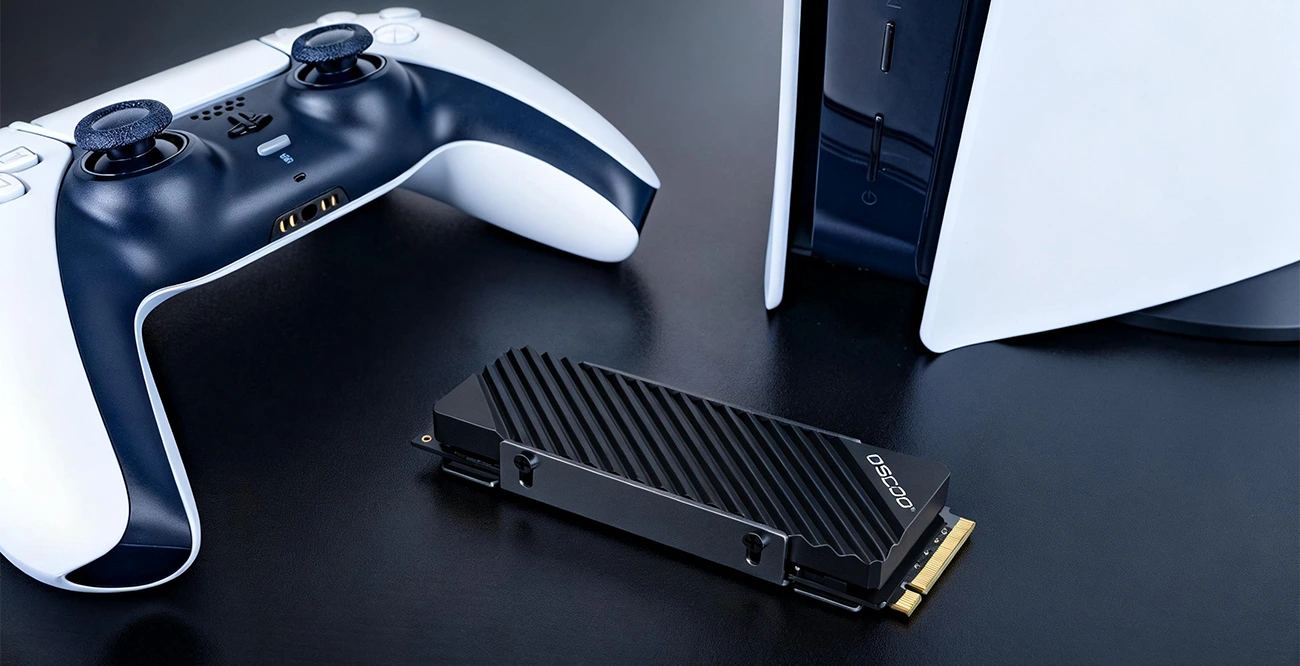Solid State Drives, or أقراص SSDs, have changed computing with their fast read and write speeds. They are now a key part of modern computers. However, this high performance comes with a challenge: the controller and flash memory chips generate a lot of heat. This is especially true during demanding tasks like transferring large files or playing big games. Too much heat can cause the SSD to slow down to protect itself. This means it may not perform at its best. It can also affect the drive’s stability and lifespan over time. Managing this heat is very important, and an SSD heatsink is a key solution.

What is an SSD Heatsink?
An SSD heatsink is a hardware part made to cool a solid state drive. Its main job is to attach to the SSD’s chips and act as a heat mover. It works by increasing the surface area exposed to air to help heat escape faster. Most heatsinks are made from metals like aluminum or copper because they transfer heat very well. They quickly absorb and move heat away from the chips.
Why Does an SSD Need a Heatsink?
The main reason to install a heatsink is to keep the SSD stable and efficient during heavy use. When the controller chip and NAND flash memory get too hot, the SSD’s protection system starts. It lowers the speed to prevent damage from overheating. This is called thermal throttling. Without good cooling, an SSD might not maintain its top speed, especially during long file transfers or running large applications. Users may see a noticeable drop in performance.
Also, constant high heat can shorten an SSD’s life. Semiconductor parts age faster when hot. Long-term overheating can lead to less stability and even data errors. Therefore, a good cooling solution is not just for better performance. It is also an important investment for data safety and longer hardware life.
For casual users doing light tasks like office work or web browsing, SSD heat is usually low. A heatsink may not be urgent. But for gamers, professional content creators, or users who often handle large data, a heatsink is very important. This is especially true for high-performance PCIe 4.0 or 5.0 SSDs. A heatsink ensures the SSD stays cool and efficient during sustained heavy load, letting it perform at its best.
The Core Question: Do I Need an SSD Heatsink?
This is a practical question. The answer is not a simple yes or no. It depends on your SSD type, your workload, and your system environment. You can decide by looking at a few key factors.
Judging by SSD Interface and Performance Level
- SATA SSDs: they have slower speeds, lower power use, and lower heat. In most cases, they do not need an extra heatsink.
- NVMe PCIe 3.0 SSDs: they are mainstream high-speed drives. Entry-level or mid-range models used for daily tasks usually have manageable heat. But high-end models used for frequent gaming or file transfers can get warm. A heatsink can be helpful.
- NVMe PCIe 4.0/5.0 SSDs: they are current and future high-performance flagships. They have very high speed, which leads to high power use and heat. A heatsink is almost necessary for these SSDs. Without one, they can easily overheat and slow down, preventing them from reaching their full potential.
Judging by Your Usage Scenario and Workload
| Usage Scenario | Example Workloads | Heatsink Recommendation |
|---|---|---|
| Light Use | Web browsing, office software, watching videos | Usually not needed. The SSD works in short bursts and generates little heat. |
| Moderate Use | Everyday gaming, light content creation, frequent software installs | Recommended. Workloads can put the SSD under high load at times. A heatsink helps maintain stable and consistent performance. |
| Heavy Use | Professional video editing, 3D rendering, constant database access, large file backups | Necessary. The SSD may be under full or high load for long periods, generating a lot of heat. Effective cooling is needed to protect performance and hardware safety. |
Making a Scientific Judgment Based on Temperature Data
The most scientific method is to check the SSD’s operating temperature using monitoring software like CrystalDiskInfo or HWInfo. 70 ℃ is a key reference point. For most SSDs, the risk of slowing down increases significantly if the temperature consistently goes over 70 ℃ to 80 ℃. If your SSD often reaches or exceeds this range under load, you need a better cooling solution. An ideal operating temperature is around 50 ℃ to 65 ℃ or lower during normal use, which usually indicates good cooling.
Other Factors to Consider
Many mid-range and high-end motherboards include heatsinks for M.2 slots. These stock heatsinks are often sufficient for moderate use. If you find temperatures are still high with the stock heatsink, you can consider upgrading to a more efficient third-party model.
System airflow and the case environment matter. In a small, poorly ventilated mini-ITX case or a laptop, heat can build up. Even a mid-range SSD might need a heatsink. Conversely, if your case has excellent airflow with lots of cool air moving past the SSD, the cooling need is much lower.
The slot position is important. If the SSD is installed below a graphics card, it gets heated by the GPU’s waste heat. In this case, cooling is even more critical.
In summary, if you are a gamer or content creator using a high-performance NVMe SSD, or if your SSD often runs too hot, investing in a heatsink is a cost-effective upgrade. It effectively protects performance and data safety.
How Does an SSD Heatsink Work?
An SSD heatsink works on a simple physical goal: to efficiently move heat from the SSD chips into the air. This process relies on two basic physical mechanisms: heat conduction and heat convection.
The process starts with heat conduction. The heatsink attaches to the SSD’s controller and NAND chips using a soft material called a thermal pad. This pad fills the tiny gaps between the chip surfaces and the heatsink, ensuring maximum contact. Because the heatsink is made from metal with high thermal conductivity, like aluminum or copper, it quickly absorbs the heat and spreads it throughout its metal body.
Next, heat convection takes over. The heatsink design usually includes many fins or ridges. These structures greatly increase the surface area exposed to the surrounding air. The heated metal surfaces continuously transfer heat to the cooler air around them. In a passive heatsink, this relies on natural convection. Hot air naturally rises, and cooler air moves in to replace it, creating an airflow cycle. In an active heatsink, a small fan blows air across these fins. This forced airflow speeds up heat exchange, carrying away much more heat.
In short, the heatsink acts as an efficient middleman. It first captures the heat through close contact and then releases it into the air through its large surface area. This keeps the SSD within a safe operating temperature range.
How to Choose the Right SSD Heatsink
Choosing a suitable SSD heatsink requires considering compatibility, cooling performance, ease of installation, and quality. This ensures it fits your system perfectly and works effectively.
- Compatibility is essential. You must ensure the heatsink size matches your SSD’s form factor. The most common M.2 2280 size is widely supported. More importantly, you need to check that the heatsink’s height does not conflict with other components in your case, especially large graphics cards and CPU coolers. The space below them is often limited.
- Assess your cooling needs. This depends mainly on your SSD model and how intensely you use it. A well-designed passive heatsink is usually enough for a mainstream PCIe 4.0 SSD or heavy use. For a very hot PCIe 5.0 SSD or extreme environments, you might need an active solution with a fan. For materials, copper conducts heat better than aluminum but is heavier and more expensive. Aluminum offers a good balance of performance and cost. The heatsink design is also crucial. More fins mean a larger effective surface area for cooling.
- Consider installation convenience. Common mounting methods include screw fixation and adhesive thermal tape. Screw mounting is more secure and reliable. Paste-on installation is simpler but may require attention to long-term stability. Choose based on your preference and skill.
- Product quality matters. Choosing a product from a reputable brand usually means reliable construction and better thermal materials. A high-quality thermal pad is essential for efficiently filling gaps and transferring heat. Before buying, checking user reviews and professional reviews can help you make a wiser decision.
Frequently Asked Questions
Q: Are heatsinks required for all SSDs?
A: No. The need for a heatsink depends mainly on the SSD model and how you use it. SATA SSDs and low-power NVMe PCIe 3.0 SSDs used for light tasks like office work usually do not need extra cooling. However, for high-performance NVMe PCIe 4.0 or 5.0 SSDs, or any SSD under continuous heavy load, a heatsink is very necessary.
Q: How effective are the M.2 heatsinks that come with motherboards?
A: The heatsinks included with most mid-range and high-end motherboards are effective enough for ordinary gaming and daily use. They are designed to handle medium cooling needs. However, if you do professional content creation or extreme overclocking, the stock heatsink might not handle the constant high heat. Upgrading to a more efficient third-party heatsink will give better results.
Q: Will installing a heatsink void my SSD’s warranty?
A: Typically, the act of installing a heatsink itself does not void the SSD’s warranty. Most manufacturers allow users to install heatsinks. The key is the installation process. If you physically damage the SSD during installation, for example by scratching the circuit board or damaging a component, that might affect the warranty. The safest approach is to check the SSD manufacturer’s warranty policy terms before you start. You can also choose an SSD model that comes with a heatsink pre-installed.
Q: How can I tell if my SSD is slowing down due to overheating?
A: The most direct method is to use hardware monitoring tools. You can use free software like HWInfo or CrystalDiskInfo to monitor the SSD’s temperature and speed in real-time while transferring a large file or running a big game. If you see the SSD temperature consistently exceeding 70 or even 80 degrees Celsius, and at the same time you notice a significant and sustained drop in read/write speed, this is usually a clear sign that thermal throttling has been triggered.
Q: Is aluminum or copper better for heatsink material?
A: Purely in terms of thermal conductivity, copper is better. It transfers heat more efficiently than aluminum. But copper has drawbacks: it costs more and is heavier. Aluminum offers a good balance. It provides effective cooling while being lighter and less expensive. For most users and scenarios, a well-designed aluminum heatsink is perfectly sufficient.
Q: Do I need a heatsink for installing an SSD in a PS5?
A: Yes, it is mandatory. Sony officially requires that any expanded M.2 NVMe SSD installed in the PlayStation 5 must have an effective heatsink. The PS5’s internal space is compact and has strict size limits, including height. Sony recommends using a metal heatsink with a thermal pad to ensure the SSD stays cool and stable under the console’s high load, preventing performance issues or system problems from overheating.
For most everyday users, a heatsink might be an optional extra. But for gamers, professional content creators, and anyone using a high-performance NVMe SSD, choosing a suitable heatsink has become an essential step. It ensures your storage device can perform at its full potential consistently and stably. Therefore, when planning your system build or upgrade, consider including an SSD heatsink. Based on your specific hardware and needs, selecting a compatible, well-designed heatsink adds a layer of security for your data and computing experience. It helps your SSD run cooler, more stable, and last longer.




